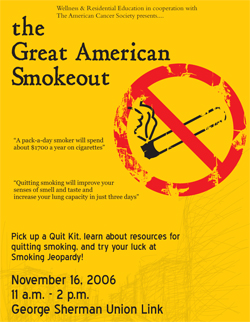The Great American Smokeout Turns 30
BU offers resources to kick the nicotine habit during the Great American Smokeout on November 16.

Not so long ago, smoking at work, in restaurants, and on airplanes was common and accepted. So even if you weren’t a smoker, you were definitely inhaling a good bit of secondhand smoke. Today most public places are smoke-free, thanks to smoking bans, greater awareness of the cancerous effects of cigarettes, and the Great American Smokeout. On Thursday, November 16, the annual event, sponsored by the American Cancer Society, will mark three decades of helping smokers quit.
Limiting the places people can smoke also reduces the number of smokers, according to the American Cancer Society. The organization says that public places in more than 2,200 U.S. communities and 17 states are smoke-free.
Public health advocates have made strides in learning which methods best help smokers kick the habit, among them nicotine replacement therapies, prescription drugs, and counseling. Boston University recently provided faculty and staff members with access to an Internet-based smoking cessation program called QuitNet, developed in part at BU’s School of Public Health.
“The Great American Smokeout challenges people to stop using tobacco and raises awareness of the many effective ways to quit for good,” says Beth Grampetro, health and wellness educator for the Office of Residence Life.
To reach out to student smokers, on November 16 Grampetro will host an interactive game of Smoking Jeopardy, hand out information about local smoking cessation programs, and provide quit kits at the GSU between 11 a.m. and 2 p.m. The quit kits can help a person trying to stop smoking deal with nicotine cravings.
“It’s not uncommon to see students smoking outside buildings all over campus and walking up and down Commonwealth Avenue smoking,” Grampetro says. “In addition, many college students consider themselves social smokers, who ‘only smoke when they drink’ or in similar social situations. They think it’s no big deal, but it’s still harmful and can lead to addiction.”
The positive effects of ditching cigarettes begin immediately, according to the American Cancer Society:
20 minutes after quitting: your heart rate drops.
12 hours after quitting: the amount of carbon monoxide in your blood drops to normal.
Two weeks to three months after quitting: your risk of heart attack begins to drop and your lungs begin to work better.
One to nine months after quitting: coughing and shortness of breath decrease.
One year after quitting: your risk of heart disease is half that of a smoker’s.
5 to 15 years after quitting: your risk of stroke is reduced to that of a nonsmoker’s.
10 years after quitting: the lung cancer death rate is half that of a smoker’s and your risk of cancers of the mouth, throat, esophagus, bladder, kidney, and pancreas decreases.
15 years after quitting: your risk of heart disease is comparable to someone who never smoked.
Meghan Noe can be reached at mdorney@bu.edu.